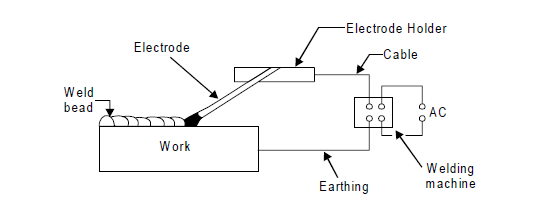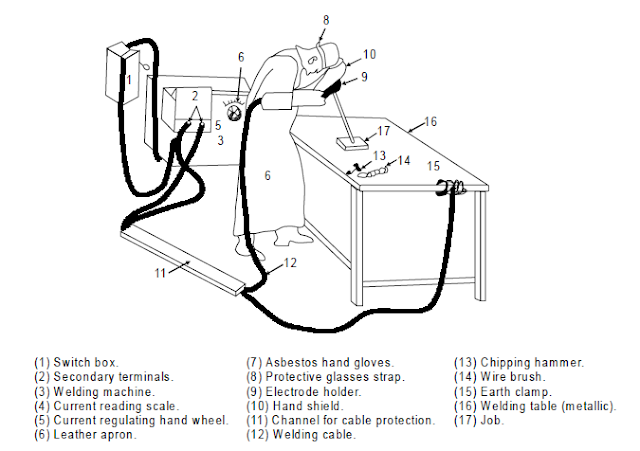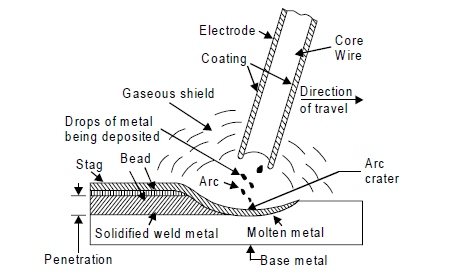Shielded Metal Arc Welding (SMAW) or Manual Metal Arc Welding (MMAW)
Shielded metal arc welding (SMAW) is a commonly
used arc welding
process manually carried by welder. It is an arc welding process in which heat for welding is produced through an electric arc set
up between a flux coated electrode and the workpiece. The flux coating of
electrode decomposes due to arc heat and serves many functions, like weld metal
protection, arc stability etc. Inner core of the electrode supply the filler
material for making a weld. The basic
setup of MMAW is depicted in Fig.
 |
Principle of
arc welding
 |
| Arc welding process setup |
The configuration of
weld zone is shown in Fig.
 |
| Arc welding operation |
If the parent metal is thick it may be necessary
to make two or three passes for completing the weld. A typical multi pass bead in this case is shown in Fig.
 |
A typical multi
pass bead
Advantages of Shielded metal arc welding (SMAW)
1. Shielded Metal Arc Welding (SMAW) can be carried
out in any position with highest weld quality.
2. MMAW is the simplest
of all the arc welding
processes.
3. This welding process finds innumerable
applications, because of the availability of
a wide variety of electrodes.
4. Big
range of metals
and their alloys
can be welded easily.
5. The
process can be very well employed for hard facing and metal resistance etc.
6. Joints (e.g., between nozzles and
shell in a pressure vessel) which because of their position are difficult to be
welded by automatic welding machines can be easily
accomplished by flux shielded metal
arc welding.
7. The
MMAW welding equipment is portable and the cost is fairly
low.
Limitations of Shielded metal arc welding (SMAW)
1. Due to flux coated electrodes, the
chances of slag entrapment and other related defects are more as compared to MIG and TIG welding.
2. Duo to fumes and particles of slag,
the arc and metal transfer is not very clear and
thus welding control in this process is a bit difficult as compared to MIG welding.
3. Due to limited length of each
electrode and brittle flux coating on it, mechanization is difficult.
4. In welding long joints (e.g., in
pressure vessels), as one electrode finishes, the weld is to be progressed with
the next electrode. Unless properly cared, a defect (like slag inclusion or insufficient penetration) may
occur at the place
where welding is restarted with
the new electrode
5. The process uses stick electrodes and
thus it is slower as compared to MIG welding.
Applications of Shielded metal arc welding (SMAW)
1. Today, almost
all the commonly employed metals and their alloys can be welded by this process.
1. Shielded metal arc welding
is used both as a fabrication process
and for maintenance and repair jobs.
2. The process finds applications in
(a) Building and Bridge construction
(b) Automotive and aircraft industry,
etc.
(c) Air
receiver, tank, boiler and pressure vessel
fabrication
(d) Ship
building
(e) Pipes
and
(f) Penstock joining
Functions of Electrode Coating Ingredients
The covering coating on the core
wire consists of many materials which perform a number of functions as listed
below:
1. Welding electrodes
are used to join various similar and dissimilar metals as plain carbon steels, cast iron, copper, aluminium, magnesium and their alloys, stainless steels and other alloy steels.
2. Slag forming
ingredients, like silicates of magnesium,
aluminium, sodium, potassium, iron oxide, china clay, mica etc., produce
a slag which because of its light weight forms
a layer on the molten metal and protects the same from atmospheric
contamination.
3. Arc stabilizing constituents like
calcium carbonate, potassium silicate, titanates, magnesium silicates, etc.; add to arc stability
and ease of striking the same.
4. Gas shielding ingredients, like
cellulose, wood, wood flour, starch, calcium carbonate etc. form a protective gas shield around
the electrode end, arc and weld pool
5. Deoxidizing elements like
ferro-manganese, and ferro-silicon, refine the molten metal.
6. It
limits spatter,
produces a quiet arc and easily removable slag.
7. Alloying elements like ferro alloys of
manganese, molybdenum etc., may be added to impart suitable properties and
strength to the weld metal and to make good the
loss of some of the elements, which
vaporize while welding.
8. Iron powder in the coating improves
arc behavior, bead appearance helps
increase metal deposition rate and arc travel speed.
9. The
covering improves penetration and surface finish.
10. Core wire melts faster than the
covering, thus forming a sleeve of the coating which constricts and produces an arc with high concentrated heat.
11. Coating saves the welder
from the radiations otherwise emitted from a bare electrode
while the current flows through
it during welding.
12. Proper coating ingredients produce
weld metals resistant to hot and cold cracking. Suitable coating will improve
metal deposition rates.
Great blog, learned many things about welding machines from this blog, very informative. Pacific weld is one of the best places to buy welding machine in India.
Automated Manufacturing System
Manufacturing Automation
Spm Machine Tools
Welding Robotic Arm
Great Yuva Welding Machines
Seam Welding Machine
Very well written article. It was an awesome article to read. Complete rich content and fully informative. I totally Loved it. single phase welding machine
I read your post and got it quite informative. I couldn't find any knowledge on this matter prior to. I would like to thanks for sharing this article here.mig welding machine price